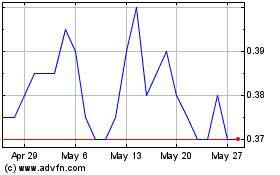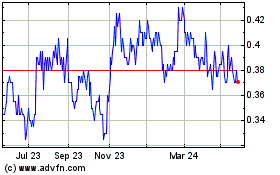Ortho-ATITM Tendon Treatment Positive in Workers Compensation Study
28 October 2015 - 1:08PM
Business Wire
- Orthocell announces new positive follow
up data for Ortho-ATITM degenerate tendon treatment in work related
injury patients
- Data shows significant positive
outcomes including reduced pain and increased functionality
- Patients with work related injuries who
have failed other treatments for tennis elbow were able to return
to work after Ortho-ATITM treatment
Regenerative medicine company Orthocell Limited is pleased to
announce the release of new positive results from a study of its
tendon cell treatment for tennis elbow in 25 workers’ compensation
patients.
The retrospective study was a collaboration between the
University of Western Australia and leading orthopaedic surgeons Dr
Alex O’Beirne from Perth and Dr Jeff Hughes from Sydney.
The data shows Orthocell’s autologous tenocyte injection
treatment, Ortho-ATITM, significantly improved the clinical outcome
of patients with long term tennis elbow degeneration, showing
reduced pain and increased functionality enabling patients to
return to work. A significant 88% of patients were able to return
to work and more than 50% of these returned at full capacity
following ATI treatment.
Assessments carried out by the treating surgeons 3-6 months
following ATI treatment showed there was a reduction in pain by
almost 90% at rest and 54% with usage of the affected limb. Most of
the patients quickly returned to work (1-3 months) with a gradual
increase in productivity to pre-injury levels (5.33 months).
“These are very positive outcomes in a group of patients that
did not respond to other treatments, with injuries that inhibited
their ability to remain in the workplace,” Dr O’Beirne said.
Dr Hughes said: “These are difficult to treat patients who are
impeded in their ability to work and to carry out their essential
duties. Ortho-ATITM has been instrumental in helping my patients to
recover from long term tennis elbow injuries which have proved
resistant to other modes of therapy.”
Patients described persistence of symptoms for an average of 22
months prior to treatment with Ortho-ATI™. Patients had failed to
respond to alternative treatments including steroid injection(s)
(60%), autologous blood and platelet rich plasma injection(s)
(28%), physiotherapy (56%), bracing (32%), acupuncture and other
(32%), or treatments with anti-inflammatories (12%). Patients had
received at least one and as many as eight prior treatments
(average of 2.52).
Orthocell CEO Paul Anderson said the data demonstrated that
Ortho-ATITM can help people with a difficult to treat tendon
injury.
“This type of injury can hinder a person’s ability to work and
lead to individual hardship, as well as significant socio-economic
costs from the loss of individual productivity and health care
costs,” he said.
Tennis elbow is a common work related injury affecting 1%-3% of
adults. Sixteen per cent of patients with tennis elbow require work
restrictions and frequently (4-5%) need prolonged absences from
work, with on average 29 days missed per patient. Office work,
health care and manual work have been identified the top three
affected occupations.1,2
Although tennis elbow is generally a self-limiting condition, it
results in significant disability, health care utilisation, lost
productivity and cost. A recent study showed that in the 18% of
tennis elbow patients who continued to require clinical care six
months after diagnosis, the median duration of care was 844 days
(Sanders, T. L. et al. Am. J. Sports Med. (2015)).
Transparency Market Research estimate that the US, Europe and
Japan markets for tennis elbow treatment is estimated to be worth
more than US$700 million in 2015.
About Orthocell Limited
Orthocell is a commercial-stage, regenerative medicine company
focused on regenerating mobility for patients and our ageing
population by developing products for a variety of tendon,
cartilage and soft tissue injuries. Orthocell’s portfolio of
products include TGA-approved stem cell therapies Autologous
Tenocyte Implantation (Ortho-ATI™) and Autologous Chondrocyte
Implantation (Ortho-ACI™), which aim to regenerate damaged tendon
and cartilage tissue. The Company’s other major product is Celgro™,
a collagen medical device which facilitates tissue repair and
healing in a variety of orthopaedic, reconstructive and surgical
applications and is being readied for first regulatory
approvals.
(1) Sanders TL, Maradit Kremers H, Bryan AJ,
Ransom JE, Smith J, Morrey BF. The Epidemiology and Health Care
Burden of Tennis Elbow: A Population-Based Study. Am J Sports Med.
2015 Feb 5; DOI:10.1177/0363546514568087. (2) Bisset L, Beller E,
Jull G, et al. Mobilisation with movement and exercise,
corticosteroid injection, or wait and see for tennis elbow:
randomised trial. BMJ. 2006;333(7575):939.
View source
version on businesswire.com: http://www.businesswire.com/news/home/20151027007138/en/
For more information, please contact:General
enquiriesOrthocell LimitedPaul Anderson, (08) 9360 2888Managing
Directorpaulanderson@orthocell.com.auorInvestor
relationsBuchan ConsultingBen Walsh, 0417 382
391bwalsh@buchanwe.com.auorMedia enquiriesBuchan
ConsultingGavin Lower, (03) 8866 1215 / 0414 796
726glower@buchanwe.com.au
Orthocell (ASX:OCC)
Historical Stock Chart
From Dec 2024 to Jan 2025

Orthocell (ASX:OCC)
Historical Stock Chart
From Jan 2024 to Jan 2025
